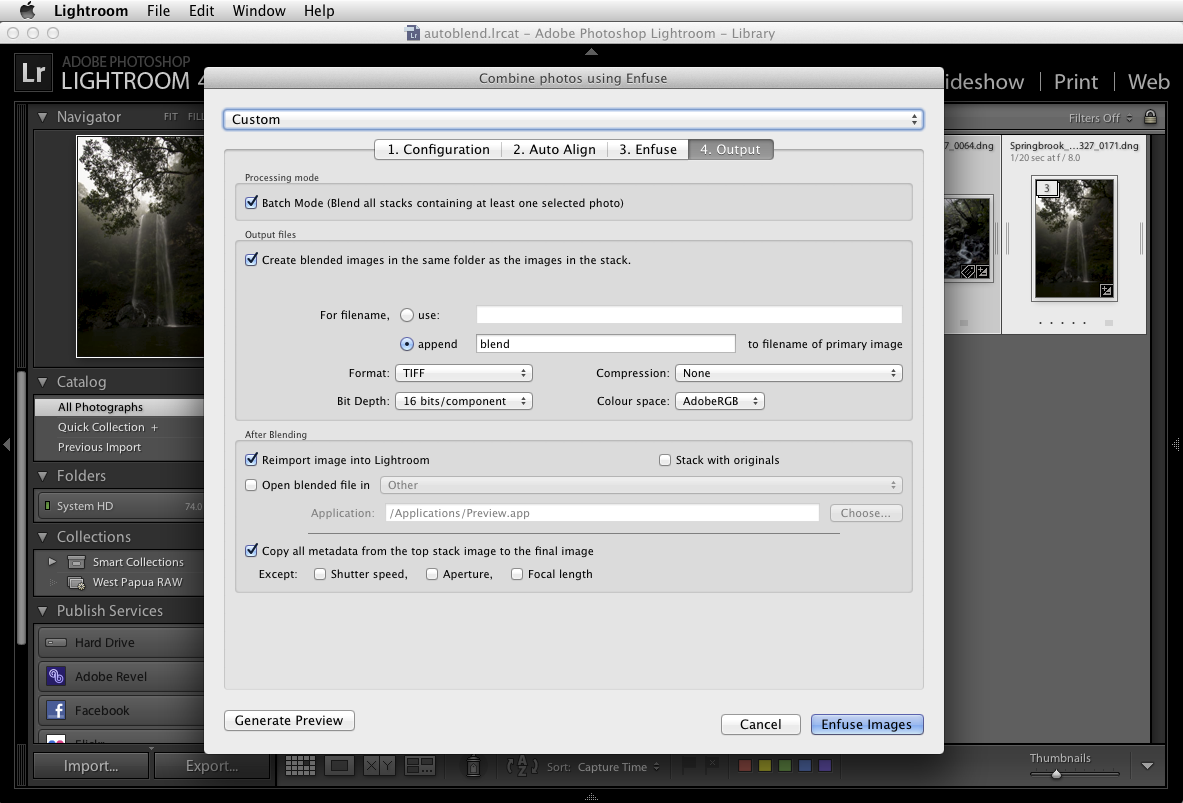You may have seen the me mention this photo in a previous post. The shot is taken using ambient light only, and yet everything is well exposed from the forground table right through to the back of the room. Normally we would expect most of the room to fall into shadow due to the high constrast difference between the window-lit table and the shaded corridor; so how was this avoided?
Expert news, reviews and videos of the latest digital cameras, lenses, accessories, and phones. Get answers to your questions in our photography forums. LR CC 8 issues with Enfuse. I am a real estate photographer and I have been using the Enfuse plug-in for years. I shoot 3 shot exposure brackets, edit the 3 shots individually in Lightroom then open the Enfuse plug-in, it blends the 3 exposures and they open in Bridge, then on to Photoshop where they get cropped, sharpened etc. Oct 17, 2016 The first one will be Lightroom’s built-in “Merge to HDR” followed by the Enfuse plug-in. Note: Ignore the ghosting – I didn’t address it in any of these examples. Above: Lightroom’s Merge to HDR feature. Above: Same images merged using the “Enfuse” plug-in. Above: The same image with Lightroom Merge to HDR but with the AUTO.
Well, it was easy actually. I took several shots at different exposures and then blended them together directly from within Lightroom using my LR/Enfuse plugin.
Isn’t that the same as HDR?
Exposure blending essentially involves examing a group of photos with varying exposures and creating a final photo, pixel by pixel, by choosing the best exposed pixel from all of the photos.
Note that this is not the same as creating an HDR (high dynamic range) image. To create an HDR image several exposures are also used, but the similarity stops there. An HDR image uses 32 bits per pixel, and these bits are used to store a floating-point value. We don’t wish to delve into the technicalities, but the result is that an HDR image allows for each pixel to contain practically any exposure value, so if the difference between the the darkest and lightest parts of an image is 20 stops, this will be faithfully preserved in the HDR’s file format.

The difficulty comes when we need to display an HDR image on media that can’t display this high dynamic range, such as a screen or a sheet of paper. The dynamic range of the image needs to be compressed to fit within the dynamic range of the chosen media. Typically this is done by controlling a tone mapping curve that dictates how and where the dynamic range is compressed.
Are the end results of the two approaches the same? Well, sometimes they can be, but mostly they’re not. Here are the main differences:
- Blending software is very easy to use but it can only produce natural looking images.
- HDR software is more complex to use, but it’s possible to create all manor of ‘unnatural’ but often very interesting styles by playing with the tone curve.
- Most people find it very difficult to create natural looking images using HDR. We know we do.
So, for interior shots like the one above, where a natural looking image is paramount, blending is definitely the way to go. It’s quick and easy. However, to create the “HDR look” blending isn’t going to help.

Enfuse
Enfuse is an open source command line application that’s part of the Hugin project.

Enfuse produces fantastic results, but the command line interface made it quite painful to use. It would certainly be a barrier to most photographers. I therefore decided to write LR/Enfuse, a plugin that would allow photographers to use Enfuse directly from within Lightroom. It’s now easy to blend images by simply selecting them and then choosing the LR/Enfuse option from the menu.
LR/Enfuse has seen several major improvements over its lifetime, including the ability to automatically align images that show a slight shift, the ability to preserve the image metadata (normally lost when using Enfuse) and, after great demand, the ability to batch process an entire shoot by grouping all the photos that will form a single image into single stack, then selecting all the stacks and calling LR/Enfuse.
A real life example
So, let’s get back to the above photo to see a real life example. Here is the sequence of images that I took.
I selected them in Lightroom and then launched LR/Enfuse with the default settings, which created a new blended photo:
Lr/enfuse Software
The blended image is often just a touch underexposed. This is no problem, we can now bring it back into Lightroom and develop it as normal. The final image shown at the top of this page is corrected for exposure and the white balance has been warmed to taste.